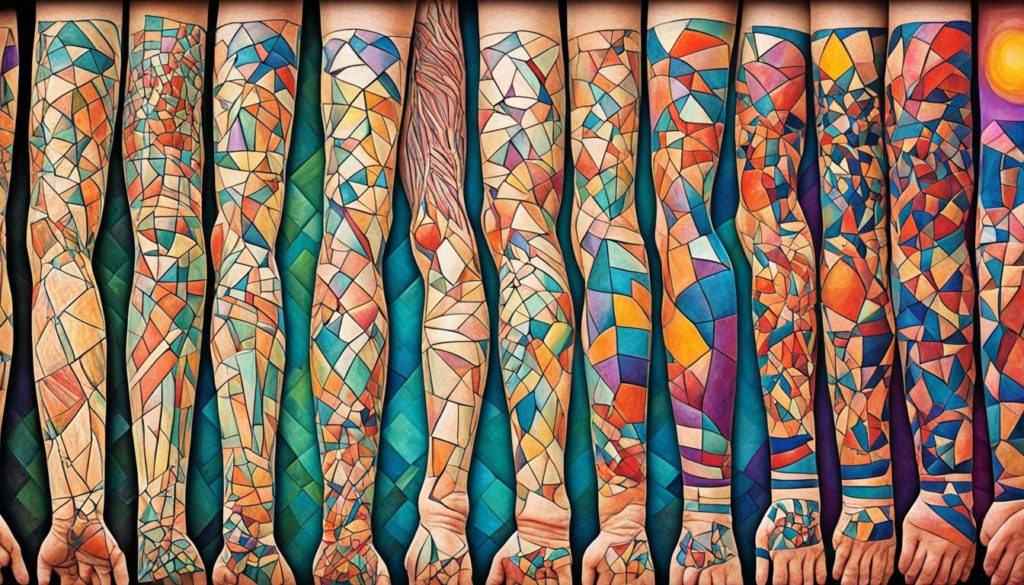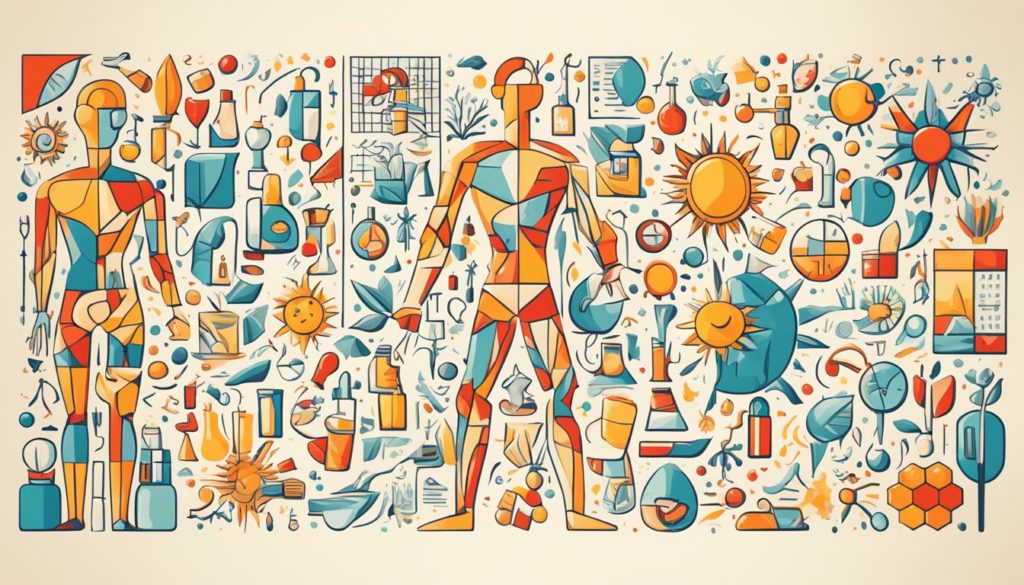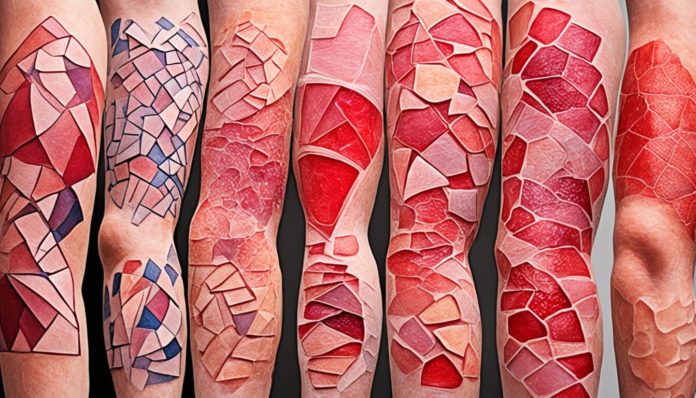Did you know more than 31 million Americans have eczema at any time? This number shows how common skin rashes are, from mild irritation to severe pain. Knowing about the different types of rashes, their causes, and how to treat them is key.
Allergic reactions and diseases can cause skin rashes. Other causes include psoriasis and environmental irritants. Finding the cause is the first step in treating a rash. Knowing about causes can make the discomfort less and keep the skin healthy.
Key Takeaways
- Millions of Americans suffer from eczema, illustrating the prevalence of skin rashes.
- Effective management of skin rashes begins with accurate identification and understanding of their causes.
- Skin rashes can result from a variety of factors, including allergic reactions, infections, and environmental irritants.
- Timely and appropriate rash treatment prevents further complications and ensures faster relief.
- A comprehensive approach to dermatological concerns includes recognizing symptoms, seeking medical advice, and adhering to recommended treatments.
What are Skin Rashes?
Skin rashes are a common concern in dermatology. They cause changes in skin texture, color, and feel. These changes can range from mild to severe, affecting skin health.

Definition of Skin Rashes
A skin rash is an area of skin that’s irritated or swollen. Many things can cause skin rashes. Yet, they often have redness, inflammation, and a change in texture.
Common Appearance
Rashes usually look like red, irritated skin patches. They might have bumps, blisters, or scales. Doctors work hard to identify rash types for the right treatment.
Variability in Symptoms
Symptoms of rashes can be mild like irritation, or severe like swelling. These symptoms help doctors find the rash type and its cause. For example, an allergy and an infection cause different rashes. This makes knowing the specific symptoms vital for treatment.
Common Causes of Skin Rashes
Skin rashes might appear for many reasons, from allergies to lasting health issues. Knowing why can help find the right solution.

Allergic Reactions
When your immune system overreacts to something like pollen, food, or medicine, an allergic reaction happens. This reaction may cause rashes, showing up as hives, red patches, and itchy skin.
Infections
Skin infections caused by bacteria, viruses, and fungi can also cause rashes. For instance, impetigo, chickenpox, and ringworm lead to unique rash patterns aiding in identification and treatment.
Chronic Skin Conditions
Long-lasting conditions like eczema and psoriasis are big reasons for rashes. They often cause ongoing itch, redness, and discomfort. Both conditions need a plan for long-term care to keep symptoms in check.
Irritants and Environmental Factors
Getting rashes can also come from touching irritants like harsh chemicals, certain fabrics, and soaps. Or from being in very hot or cold weather and high or low humidity. This kind of rash, known as contact dermatitis, happens when your skin reacts after touching these things.
“The skin often mirrors the internal climate of the body, and understanding the triggers of skin rashes can lead to more effective prevention and treatment strategies.”
| Cause | Symptoms | Examples |
|---|---|---|
| Allergic Reactions | Hives, Redness, Itching | Food Allergies, Pollen, Medications |
| Infections | Blisters, Pustules, Redness | Impetigo, Chickenpox, Ringworm |
| Chronic Skin Conditions | Persistent Itching, Inflammation | Eczema, Psoriasis |
| Irritants and Environmental Factors | Redness, Itching, Swelling | Chemicals, Fabrics, Extreme Temperatures |
Symptoms of Rashes
Rash symptoms can vary a lot. They affect how severe and long a skin inflammation lasts. Knowing these symptoms helps spot the causes and treatments.
Itching and Redness
Itching and redness often show up first. These signs mean the skin is inflamed and uncomfortable. The itching might be light or very strong.
Intense itching can make the skin even more inflamed. This happens because of constant scratching.
Swelling and Pain
Swelling and pain are also common with rashes. They can mean the reaction or infection is worse. The swollen area might be warm and hurt a lot.
This needs a doctor’s care to avoid more problems.
Blisters and Bumps
Blisters and bumps often point to allergic reactions or conditions like eczema. They can be filled with liquid or be hard. If they break, the skin may crust or scab.
Watching these changes helps doctors find the right treatment.
Types of Skin Rashes
It’s crucial to know the different types of dermatitis. This includes atopic dermatitis (eczema), contact dermatitis, psoriasis, and rosacea. Each one shows up differently on the skin and has unique triggers. Recognizing these conditions is key to getting the right treatment.
Atopic Dermatitis (Eczema)
Atopic dermatitis, also called eczema, is a long-term skin issue. It makes your skin dry, itchy, and inflamed. It’s more common if your family has a history of allergies or asthma. Things like soaps, detergents, and stress can make it worse.
Contact Dermatitis
Contact dermatitis happens when your skin touches something irritating or an allergen. It leads to a red, itchy rash. Irritants can be cleaning supplies and chemicals. Allergens might be things like poison ivy or metals in jewelry.
Psoriasis
Psoriasis is a long-lasting autoimmune disease. It causes too many skin cells to grow quickly, making scales and red spots. These often appear on elbows, knees, and scalp. Triggers include stress, cold climates, and infections.
Rosacea
Rosacea is a chronic condition focusing on the face. It makes you red, shows blood vessels, and can cause bumps. Triggers are spicy foods, alcohol, and hot or cold weather. Rosacea is usually found in people with lighter skin and can come and go.
- Atopic Dermatitis (Eczema): Associated with allergies.
- Contact Dermatitis: Due to direct contact with irritants.
- Psoriasis: Autoimmune disorder with rapid cell buildup.
- Rosacea: Chronic condition primarily on the face.
Diagnosing Skin Rashes
Finding out what a rash is, takes more than just looking at it. The process of rash diagnosis is detailed. Doctors start by learning about the patient’s health history. They ask about symptoms, life changes, and possible allergens that have been contacted. This information is key for a complete skin condition assessment.
When checking the rash, doctors look closely at where it is, its color, texture, and how it’s spread. These clues help figure out the cause and type of skin rashes.
Sometimes, tests like a skin biopsy might be needed to get more information. In this test, a small skin piece is examined in a lab. It can show if there are any deeper issues or infections. Also, allergy tests can pinpoint what might be causing the rash.
Here’s a table that shows the steps a dermatologist consultation takes during rash diagnosis:
| Step | Purpose | Outcome |
|---|---|---|
| Medical History | Gathering comprehensive health and symptom information | Identifying potential triggers and patterns |
| Physical Examination | Visual and tactile assessment of the rash | Differentiating between types of rashes |
| Skin Biopsy | Laboratory analysis of skin sample | Confirmation of underlying conditions |
| Allergy Testing | Identifying specific allergens | Formulating targeted treatment plans |
Treatment Options for Skin Rashes
To treat skin rashes well, it’s important to know about all available options. This includes over-the-counter products, prescription meds, and home remedies. You need to weigh the pros and cons of each to keep your skin healthy.
Over-the-Counter Medications
Over-the-counter options can help with mild rashes. Antihistamines reduce itching and swelling from allergies. Creams with corticosteroids can lower inflammation and make you more comfortable.
Prescription Treatments
For tough cases, you might need prescription treatments. Dermatologists may prescribe stronger drugs to deal with inflammation and rash symptoms. If over-the-counter antihistamines don’t cut it, they might suggest something stronger.
Home Remedies
Some folks prefer natural treatments. Things like oatmeal baths, aloe vera, and coconut oil can calm your skin. These natural options can help without the downsides of some medicines.
| Treatment Type | Examples | Benefits |
|---|---|---|
| Over-the-Counter | Antihistamines, Corticosteroid creams | Accessible, Immediate relief |
| Prescription | Stronger Corticosteroids, Systemic Antihistamines | Effective for severe cases, Long-lasting relief |
| Home Remedies | Natural Skin Care (Oatmeal baths, Aloe vera, Coconut oil) | Minimal side effects, Cost-effective |
Prevention of Skin Rashes
To keep your skin healthy and strong, preventing rashes is key. We’ll share some top ways to avoid rashes. These include knowing what causes your rashes, caring for your skin correctly, and eating right.
Identifying Triggers
Knowing what causes your rashes is the first step to avoid them. Common causes are allergens, irritants, and the environment around us. Things like certain chemicals, materials, or plants can lead to rashes. By being aware of these triggers and dodging them, you can cut down on rashes. For more details, check out this resource.
Adopting Skin Care Routines
Having a good skin care routine shields your skin from rash causes. Here are some helpful tips:
- Use gentle, fragrance-free products to avoid harsh chemicals.
- Keep the skin clean and moisturized to maintain its protective barrier.
- Avoid tight clothing that can cause friction and irritation.
- Regularly wash bedding and clothing to remove potential allergens.
Nutrition and Hydration
Eating right plays a huge part in keeping your skin healthy. A diet full of vitamins, minerals, and plenty of water helps a lot. Eating lots of fruits and veggies, which have antioxidants, supports the skin. This helps your skin fight off irritants and heal from damage.
Staying proactive in these areas can keep your skin clear and free from irritation. If you’re worried about a rash or another skin issue, always talk to a doctor. They’ll give you the right diagnosis and way to treat it. For more guidance, look here.
When to Consult a Dermatologist
Knowing when to get help for skin rashes is very important. If home treatments don’t work, seeing a dermatologist is key. They offer expert care, especially when symptoms get worse.
Persistent or Worsening Symptoms
If your rash doesn’t get better with usual care, or gets worse, you should see a specialist. Symptoms like oozing, blisters, severe pain, or affecting your day-to-day life need urgent care. It’s crucial to get a dermatologist’s advice to avoid more problems and find relief.
Uncertain Diagnosis
Figuring out what’s causing your rash can be tough. If you’re struggling to identify the cause, or if nothing has worked, you need a skin expert. They have the skills and tools to find out what’s wrong and how to treat it.
Specialist Treatments
Some skin problems need special treatments that you can’t get on your own. Dermatologists have access to stronger medicines and specific therapies. They make sure you get the right, complete treatment.
Seeing a dermatologist early can make treating skin rashes much better. For details, check out Forefront Dermatology to learn when to seek expert help.
FAQ
What are some common causes of skin rashes?
Skin rashes can spring from allergies, infections, or conditions like eczema. They can also be caused by irritants or the environment. Knowing the cause is key to treating them right.
How can I identify the type of rash I have?
To identify your rash, check its look, symptoms, and triggers. Changes in texture or color help. A dermatologist can also help by diagnosing it and suggesting treatments.
What are the typical symptoms of skin rashes?
Rash symptoms often include itching, redness, and swelling. You might also see blisters or bumps. These signs can tell you a lot about the rash’s cause.
How can I treat my skin rash?
You can treat rashes with over-the-counter drugs, prescriptions, or home remedies. Using antihistamines or corticosteroids can ease symptoms and help your skin heal.
Are there ways to prevent skin rashes?
To prevent rashes, avoid known triggers and stick to a good skin care routine. Good eating habits and staying hydrated also help keep rashes at bay.
When should I consult a dermatologist about my rash?
See a dermatologist if your rash gets worse or doesn’t go away. If you’re unsure what it is or need special care, they can guide you right.


